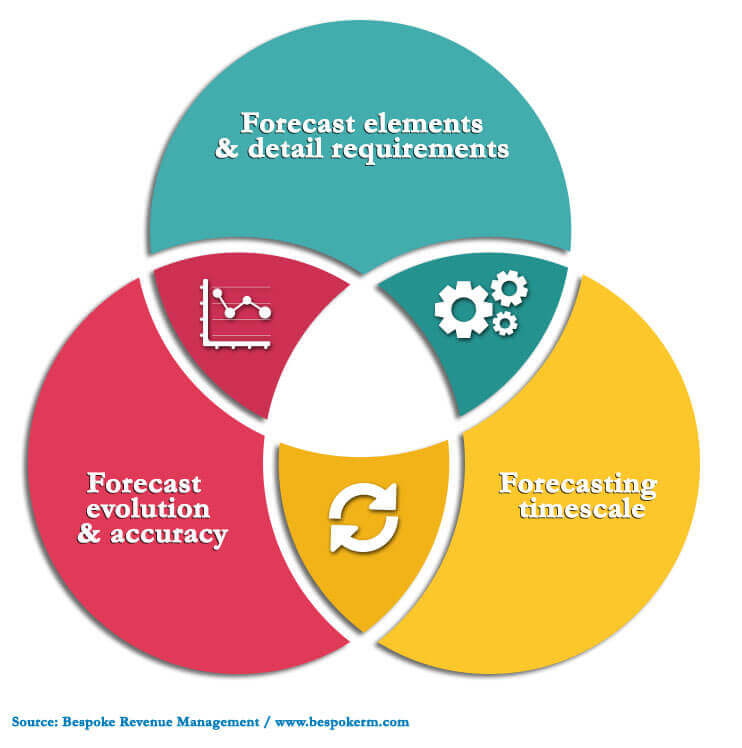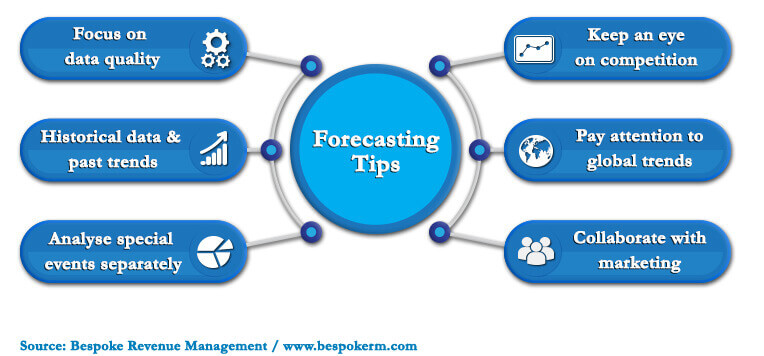Today’s hospitality landscape is characterized by increasing room supply and high cost margins.
NB: This is an article from Bespoke RM
And while there is enough space for everyone to excel at delivering optimum performance & results, the stiff competition makes it imperative for hotel revenue managers to constantly adjust in order for their strategies to remain relevant. This is even more sensitive when the seasonality of the business is considered.
Accurate demand forecasting is extremely important for a business as it drives strategic planning aimed at optimising sales, increasing operational efficiency, improving customer service and maximising profit. Predicting what the customer wants, anticipating the sales of products and services helps managers understand revenue opportunities and make informed decisions about pricing and business growth strategies.
With a holistic revenue management plan, a hotel can be confident it is still running with the most profitable business mix while all revenue streams are optimized and designed to improve customer service. Much has already been discussed about the components that are vital for an effective Total Revenue Management process (TRM) in earlier installments in this series. This article will focus on forecasting by revenue stream as a necessary tool for a successful total revenue management plan.
What is forecasting?
In simple terms, forecasting is the process of predicting future developments in any hotel by using past and present data. It involves attempting to gain an insight into the future while relying solely on past trends and present events. Forecasting is the scientific version of crystal gazing and while future events may deviate from past trends, the intelligent insights obtained from forecasting, provide a reliable platform to build upon.
Forecasting hotel demand and revenue accurately can prove difficult. Though the seasonality lends some much-desired predictability to the task, factors such as changes in the market, consumer behavior etc., still make it seem like trying to hit a moving target. But it must be done and done right if a hotel is to maximize revenue & profitability. Vital business decisions bordering around pricing, advertising, distribution etc. are all made based on the conclusions drawn from a forecast.
The importance of forecasting to TRM
As hinted earlier, many management decisions rest on the quality of forecasts making it even more germane to total revenue management. Total revenue management focuses on increasing revenue across all revenue streams, rather than simply relying on revenue generated from rooms. Forecasting helps to generate relevant strategies to achieve this. A good forecast would not only predict when clients would be coming into a hotel. It would also give an insight into associated data like where they would be coming from, how they book, the duration and purpose of their stay, trends on spend in other revenue streams etc.
A hotel located in a leisure area, for example, would naturally expect a spike in demand during the tourist seasons. Traditional revenue management systems would only move to manipulate the rental prices of rooms during this period. There is only so much revenue that can be generated with this approach if the hotel management doesn’t want the strategy to backfire. TRM on the other hand would employ data to come up with additional services that would increase patronage and revenue. In a previous article we talked about Seamless technology. Data gathered from various sources are a key component in deciding services to introduce, improve or replace in an effort to anticipate changes in consumer behaviour.
Forecasting becomes all the more important when we consider the key matrices that can be improved upon during different demand seasons. Forecasting takes all these into considerations and provides reliable data from which informed decisions can be made.
Forecasting models
There are numerous models of forecasting but they all stem from two major models. Every method that is used to make a forecast is based on these two models which are qualitative and quantitative models
Qualitative models: the scope of this forecast is limited and is utilised in making short-term predictions. It is used in making a short-term success of the hotel organization and enhances the quality of the services rendered. It is expert driven and does not involve historical data.
Quantitative model: this involves the use of statistics to discern the trends and progress of the organization. It is used for long-term predictions. This type of forecasting is accurate as it based on the utilization of a large amount of data. It takes into account data such as market segment profitability by revenue stream, cost of sale, statistics on channel and boking source, booking pace, geographic origin of business etc.
Forecasting process & tips
As mentioned earlier, accurate forecasting could prove a daunting task for even the most experienced revenue manager. So how do we accurately forecast demand? Forecasting is both a science and an art as it requires statistical analysis of historical data and trends as well as flexibility of mind to make assumptions on elements that have no trend or are new to the business and therefore have a high level of uncertainty. But, it is far from impossible.
There are 3 steps that need to be considered before establishing forecasting requirements:
- Define the elements that need to be forecasted in line with targets and how detailed your forecast needs to be
- Define the timescale of forecasting in line with business needs
- Continuously monitor forecast evolution & accuracy

1) Define the elements that need to be forecasted in line with targets and how detailed your forecast needs to be
A business should decide which elements need to be forecasted by looking at business activities that drive profit and Key Performance Indicators that, if met, will ensure achievement of targets. In hotels, the most common KPIs are occupancy, ADR, RevPAR. Exceeding last year occupancy level and rate whilst maintaining cost at a similar level of prior years, should lead to certain profit. A good forecast should also look at market segmentation as each segmented customer has different purchase intentions and therefore purchasing requirements, preferences, expectations, booking trends, etc.
A family going on a holiday break will have different requirement than a business traveller attending a conference. Forecasting each of these customer requirements and spend will not just allow the organisation to plan operations around meeting these requirements but also decide which of these customers is more valuable for the organisation and therefore which one to take and which one to turn down. When forecasting demand by segment, an organisation should not just look at the base rate but also consider ancillaries and cost of sale as the total revenue generators may be different than the single value of selling a room.
Each organisation needs to find the right balance between detailed and aggregated forecast. Forecasting by revenue stream does not entail performing a thorough forecast for each revenue source, rather keeping in mind contribution and cost. An optimum contribution should have high enough returns to aid strategic planning and enough details to produce a robust forecast (the higher the number, the more accurate the forecast).
2) Define the timescale of forecasting in line with business needs
It is crucial to define the period to forecast, how far in advance an organisation should forecast and how often/the re-occurrence (next 3 months, 1 month out, weekly forecast, etc.).
When deciding timescale’s for forecasting we should consider the business requirements and the lead time the hotel needs to react to changes in the forecast. Depending on the market a hotel is based in, forecasting needs to be done as far in advance to match booking pace patterns in-line with demand.
3) Continuously monitor forecast evolution & accuracy
Forecasting is an ongoing process as it reflects the constant changes in BOB, (Business on the Books), and booking pace while it reflects on strategies in place and the impact they have on how business materialises.
Measuring and evaluating forecast accuracy is as important as forecasting itself. It allows a view in common errors in how a forecast is constructed while in can highlight previously missed patterns. As forecast deviations are inevitable, extra effort is required in keeping track of accuracy to facilitate reducing errors to a minimum.
One of the best metric to use when measuring forecast accuracy is the Mean Absolute Percent Error (MAPE), as it represents the forecast error in percentage and absolute terms.
MAPE = (Absolute Value (Actual – Forecast) / Actual) x 100
Calculating the square root of the variance in error (Standard deviation) can also help improving the forecast as it will identify not just the average difference between actual results and forecast, but also the spread of accuracies.
It is a good practice to predict first the “unconstrained” demand, the “real” consumer demand not affected by managerial decisions, yielding actions or supply constraint. In order to do so it is important to analyse historical data taking into consideration not just the business accepted/booked but the amount left on the table (turndown, rejected bookings, etc.).
Once unconstrained consumer demand has been established, RM can calculate the segment that will bring the most total revenue and profit. The unconstrained forecast becomes “constrained” and this will be the “plan” to distribute to relevant stakeholders that if successfully executed will bring the highest revenue and profit for the organisation.
Below are some tips that could aid forecasting efforts.
- Proper documentation – focus on quality
The major pillar behind any accurate forecast is accurate data. It is, therefore necessary that hotels should keep proper records of past events and trends in order to project accurately into the future. The diversity of the records could make the task even more difficult. Having a revenue culture in your hotel will make it easier as the importance of accurate data is easily understood and implemented by everyone.
- Collection of historical data & analysis of past trends
The seasonality of the hotel business makes historical data the best forecasting tool around. Although the projections obtained thereof may not be completely accurate, it still provides a good idea of when to expect spikes in demand and provide a detailed road-map of booking pace and patterns.
A thorough rooms forecast should involve analysis by market segment, by day. When forecasting by day it is imperative to compare like to like and therefore analysis should be done by Day of the Week and not by date. It is also important to have an indication of pace and how current trading variances from the average booking patterns for the specific day / segment.
- Identify and analyse special events separately
It is imperative to monitor special events and holidays alongside the historical data. This will provide with a solid understanding of seasonality trends and any pattern that happens often enough to predict their repetition. It will also be easier to highlight deviations for past patterns which may signal reviewing or changes to current strategies. As above analysis needs to be made on Day of the Week basis to ensure like to like comparison. Lastly it can help identify changes in consumer behaviour (booking window, customer requirements, etc.) and decide which elements to include or exclude (anomalies) from future forecast
- Be aware of what the competition is doing right
It is true your hotel should have its own unique methods and strategies, but the competition in the hospitality industry is such that you wouldn’t want to be left behind. Keep tabs on the competition’s pricing strategies, advertising techniques, get to know if a hotel recently opened in your area or if a hotel just embarked on extensive renovations. Then do what you can to stay on top of your game.
- Pay attention to global trends
This is particularly important to a hotel that enjoys a lot of international business. Follow the general trends in the hospitality industry. Has there been a recent decrease in the industry’s viability? Is the economic situation in a particular country having a negative or positive impact on the industry overall? Monitoring these trends would give you a fair idea of what needs to be adjusted and where you need to focus your efforts.
- Collaborate with the marketing department
Your forecast data should factor and guide the efforts of the marketing and sales department of your hotel. You should know how your hotel is being projected to the people and where your demand is coming from. Forecast data can also help channel marketing efforts. If forecast data shows a lack of interest from a particular market segment, marketing efforts may be steered towards attracting that segment.

Forecasting is germane to total revenue management in the hospitality industry. An accurate forecast gives the much-needed peek into the future and affords revenue managers a strong platform on which projections can be made. Remember, the idea behind the concept of total revenue management is to increase the revenue generated across the board and not simply focus on the revenue generated from room rentals. A comprehensive forecast data would, therefore, not only focus on demand but also on the origins of the demand and related information and details on how revenue is spend throughout all outlets. Having an insight into such associated information informs decisions that would aid total revenue management efforts.







